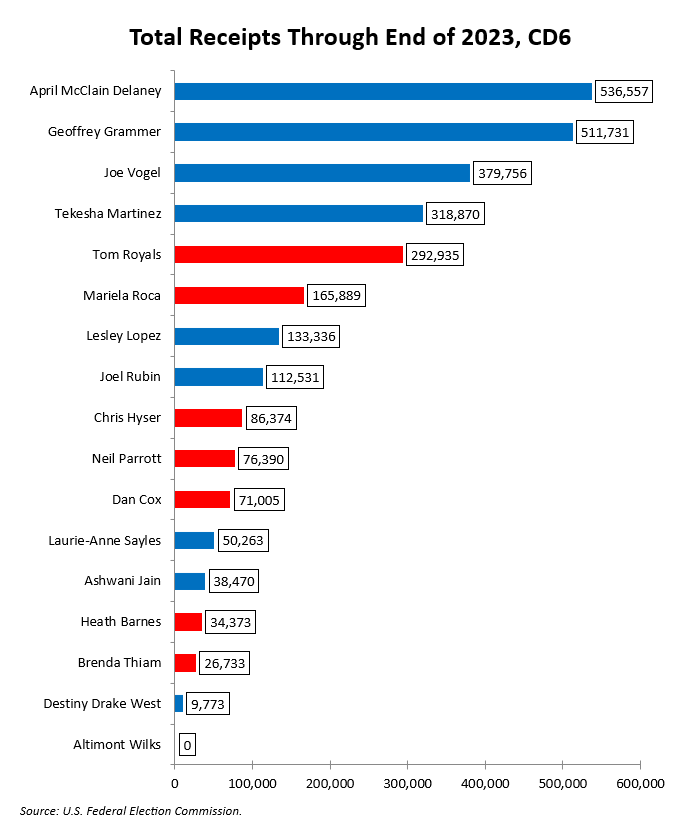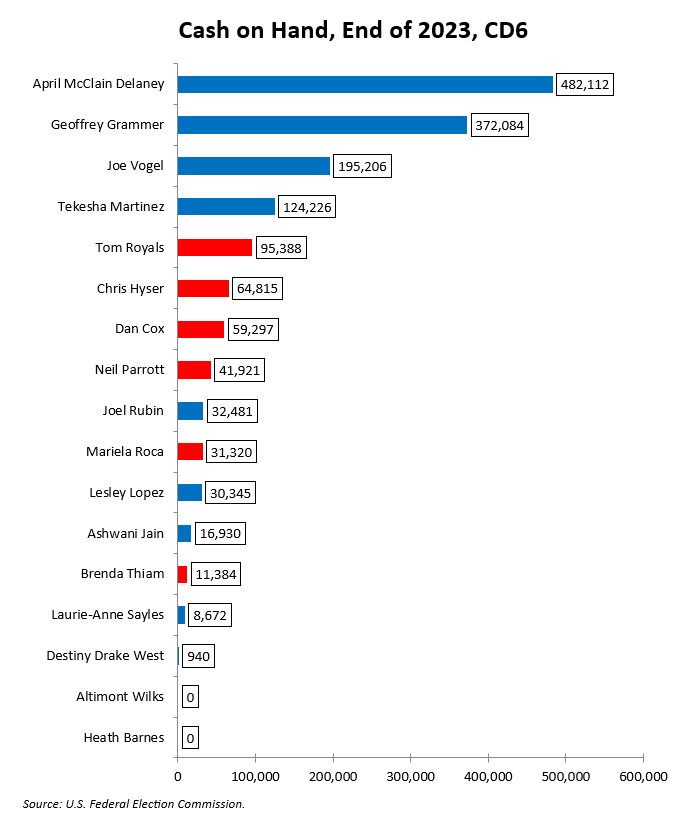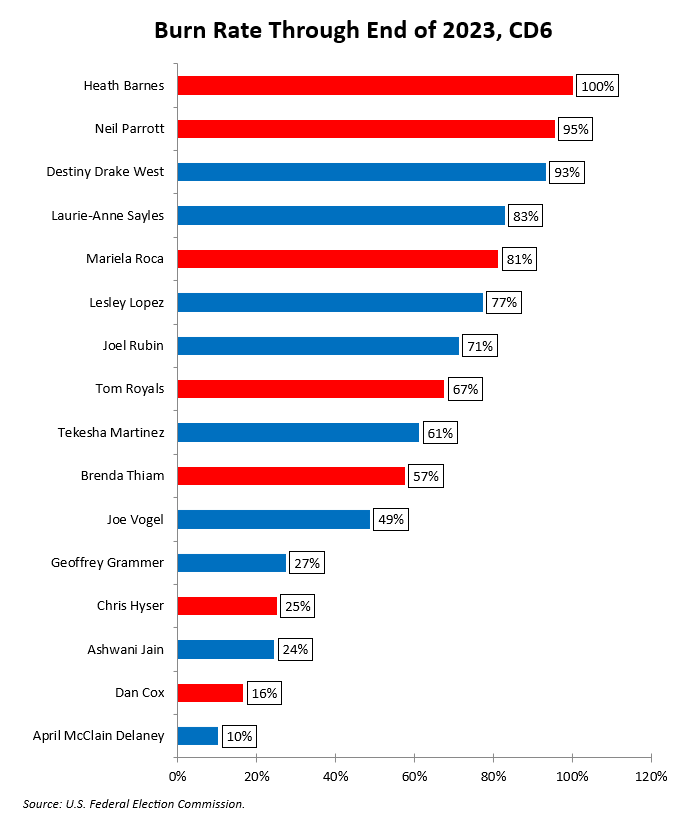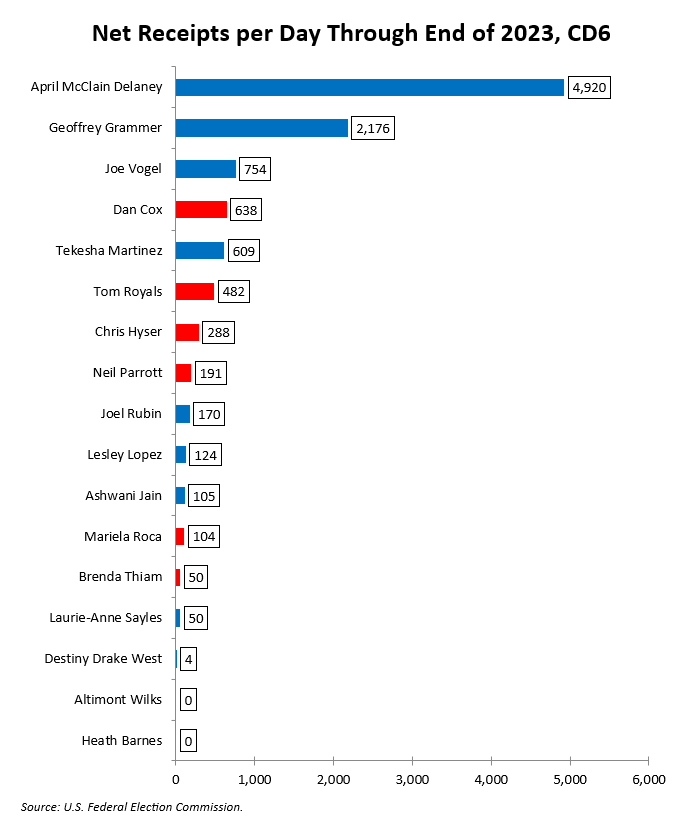By Adam Pagnucco.
Back in October, I wrote a four-part series on campaign finances in Congressional District 6. (Here are the links for Parts One, Two, Three and Four.) Since then, April McClain Delaney, the wife of former Congressman John Delaney, has entered the race and new reports were released at the end of January. This is the second-to-last round of reports prior to the May 14 primary. The last will be due on April 15.
I will have more to say about campaign finances in this district, but for now, let’s present four quick stats.
Total Receipts
The chart below shows total receipts by candidate through the end of 2023. Democrats are in blue and Republicans are in red.

McClain Delaney is the leader followed by Geoffrey Grammer, who has self-financed 86% of his receipts. The top four recipients are all Democrats.
Cash on Hand
The chart below shows cash on hand at the end of 2023.

The top four in total receipts are also the top four in cash on hand. Right away, we can tell that at least half of these candidates are not financially viable.
Burn Rate
The chart below shows burn rate, which is the percentage of receipts that has already been spent. It’s important for candidates to minimize burn rate in the early months of a race so that they can finance mass communications to voters at the end. Here is a case study of the consequences of high early burn rate.

McClain Delaney is not only the leader in receipts and cash on hand – she also has the lowest burn rate in the field. (Altimont Wilks, a brand new Democratic candidate, has neither raised nor spent any money and therefore has no burn rate.)
Net Receipts per Day
This stat divides cash on hand by days in the race. Effectively, it combines the prior two stats into one stat measuring financial momentum.

Again, McClain Delaney is the story. She blew away everyone during her first 98 days in the race.
Maryland Matters founder Josh Kurtz has noted that McClain Delaney has not raised money inside the district and a substantial amount of her receipts apply only to the general election. While significant, those observations need context.
First, as I noted in October, CD6 is not a great place to raise money. It contains none of the traditional financial centers of Maryland politics, which are Montgomery County’s Democratic Crescent, Annapolis and some of the wealthier Baltimore suburbs. As of the end of the third quarter, just 4% of the entire field’s total fundraising came from itemized individual contributions inside the district. At some point I will update that data, but it would not surprise me if none of the candidates are getting a lot of money from inside the district.
Second, as Josh noted, McClain Delaney has not yet self-financed. Her husband, former CD6 Congressman John Delaney, self-funded $3.7 million in his three races for Congress and an additional $11.4 million in his 2020 campaign for president. If McClain Delaney has liquidity problems in the primary, she can easily plug the hole by herself. Other than fellow Democrat Geoffrey Grammer, who has loaned his campaign $439,689, I don’t know if any of the other candidates can say that. Additionally, two other Democratic candidates – Delegates Joe Vogel and Lesley Lopez – are back in Annapolis through sine die on April 8. That will impede their ability to raise money and work the district.
The bottom line is that April McClain Delaney is in a strong position, at least financially. She leads on all four measures above and did so with no self-financing. Her nearest financial competitor is a self-funder (Grammer) who is running for Congress for the first time. It’s too early to start calling McClain Delaney “Congresswoman,” but it’s time for one of her opponents to show enough game to stop her.
